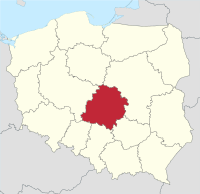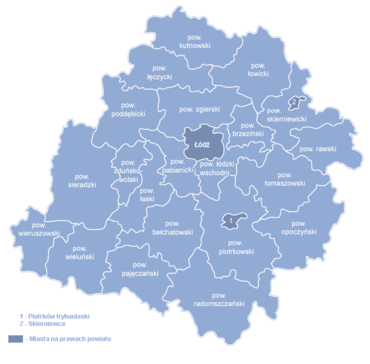Łódzkie
Łódź Voivodeship (Polish: województwo łódzkie) is a province in central Poland, formed around the major city of Łódź.

Cities
- 🌍 Łódź — once renowned for its textile industries, the Polish Manchester has the longest walking street in Europe
- 🌍 Bełchatów
- 🌍 Kutno — an important industrial hub has a small but beautiful old town
- 🌍 Łowicz — with two market squares (one triangular!) and nearby parks and palaces, this charming little town and a hub of local folk culture is well-connected to major transit corridors
- 🌍 Pabianice — south of Łódź is this often-overlooked pearl of 19th-century heritage
- 🌍 Piotrków Trybunalski — the second-largest city in the voivodeship boasts rich history reaching the medieval times
- 🌍 Radomsko
- 🌍 Skierniewice — the capital of horticultural sciences offers a surprising variety of built heritage
- 🌍 Tomaszów Mazowiecki
Other destinations
Understand
Łódź Voivodeship is in the centre of Poland. The capital is Łódź, which is the third biggest city in Poland. In geographical terms, the Łódź region is located on the Central Polish Lowland, in proximity to the Świętokrzyskie Mountains.
The present-day Łódzkie is an amalgamation of cities and lands with very different history, brought together by their central location. It is a rather urbanized and industrialized region, even if the prevalent industries are the light ones, compared to the heavy industry in Silesia southwards from Łódzkie. As there is no major river flowing through Łódzkie, it benefitted greatly from the construction of railways that started in the 19th century, and there are many important railway nodes in the voivodeship. Moreover, Poland's two most important motorways, the North-South A1 and East-West A2, cross in Łódzkie, providing further boost to the development of logistic centres and business/industry parks.
Having said which, Łódzkie is also rich in pre-industrial historic and folk heritage, which can be evidenced in many of the smaller towns and villages across the voivodeship. There is a wealth of local cultures and traditions, simple but very tasty cuisine and stories involving big historic names such as Napoleon or numerous Russian Tsars. While off the map for most tourists, Łódzkie is far from flyover country.
History
In the early Middle Ages the Łódź region was part of Greater Poland which was the major part of Poland in the 10th century. However, the capital of Poland was moved from Gniezno to Kraków in 1040. When in 1138 the Seniorat of Poland was formed, what is now Łódź region was part of three different duchies: the south-eastern part of Greater Poland, Sieradz and Łęczyca. These three were soon reunited, and became part of the Kingdom of Poland in the beginning of the 14th century. Piotrków Trybunalski played an important role in Polish parliamentarism, as this was the place where the most Polish Sejms gathered since the 15th century.
After the Second Partition of Poland in 1793, most of its territory was annexed by Prussia, but became independent as part of the Duchy of Warsaw between 1807-1815. After the Congress of Vienna it became part of the Kingdom of Poland, ruled by the Russian Tsar. Łódź, often referred to as the Polish Manchester, emerged as a major industrial city in Central Europe in the early 19th century. After World War I Łódź region became part of the Second Polish Republic, but was occupied by Nazi-Germany between 1939 and 1944, when it was part of the German Generalgovernement. After World War II it again became part of Poland. Nowadays it is in the heart of the country.
Talk
There is no major dialect or accent of Polish notable within Łódzkie. Many inhabitants do not speak any foreign language, but if they do, English is your best bet among the younger generations and with most service sector employees. Despite being in the Russian sphere of influence for almost two centuries, you won't find many fluent Russian speakers - much more probably, some of the younger people you encounter will speak another Western European language besides English, like German or French, due to many international companies locating their subsidiaries and service centres in Łódzkie.
Get in
By plane
- Łódź Władysław Reymont Airport (LCJ IATA) is a relatively small airport served by Ryanair, Wizzair and SAS, the latter offering connecting flights to most major airports in Europe via its hub in Copenhagen.
- Warsaw's Frédéric Chopin Airport (WAW IATA) is only about 100 km away from Łódź.
By train
- Łódź Fabryczna is the terminal for trains that originated in Poland with Łódź as a stop. This station is centrally located and announcements are in Polish, English and German. It reopened in 2026 after reconstruction.
- Łódź Kaliska is the more international train station that services riders from the Czech Republic and Germany.
The most important railway infrastructure points in the region are Koluszki (east from Łódź) and Kutno (north from Łódź, between Poznań and Warsaw).
By car
Poland is planning an extensive network of highways, but until this project is completed the best advice is to check a map or an atlas.
Several completed and planned international highways that will pass through or by Łódź are listed below.
- A - 1 from Scandinavia via Gdańsk, Toruń, Łódź, Częstochowa, Katowice to Balkans.
- A - 2 from London via Brussels, Amsterdam, Berlin, Poznań, Łódź, Warsaw, Minsk to Moscow.
- A - 8 from Paris via Strasbourg, Cologne, Dresden, Wrocław, Łódź, Warsaw, and from Geneva via Munich, Prague, Wrocław, Łódź, Warsaw.
Get around

See
Do
Eat
Drink
Stay safe
Go next
Łódź Voivodeship borders six other Polish voivodeships (from South, anticlockwise):